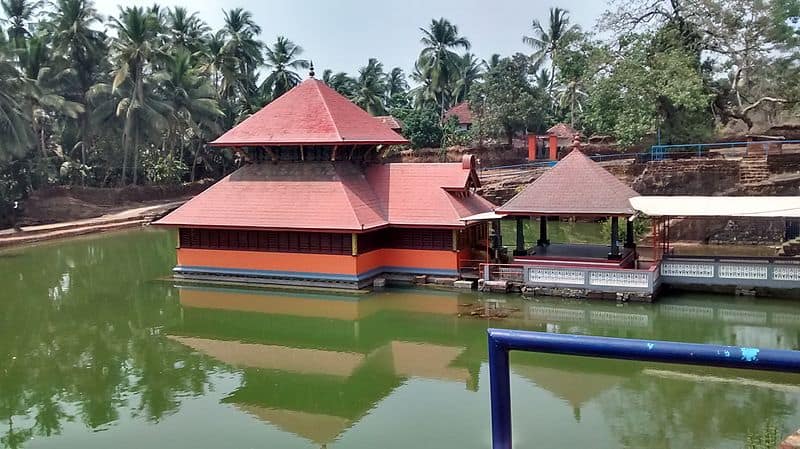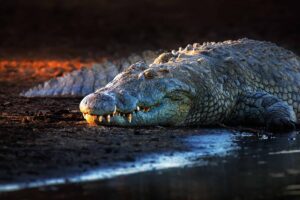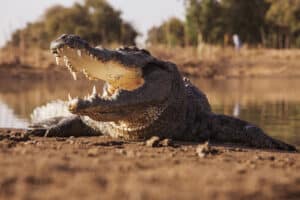In the Kasaragod district of Kerala in southern India, there is a very unique temple built in the middle of a lake. But it is not just the temple’s location that makes this sacred site so unique. For the past 70 years, the Ananthapura Lake Temple has also been home to a rather unusual patron. While Hindu priests walk the temple’s halls, a much scalier creature stands guard in the water surrounding it. Her name is Babiya, and she is not your ordinary temple guardian. Babiya is a vegetarian crocodile!
I know what you’re thinking: a vegetarian crocodile? Is this a joke? We all know that crocodiles are killer carnivores that instill fear everywhere they go. These living dinosaurs are terrifying creatures that very few of even the top predators choose to mess with. And yet, contrary to everything we thought we knew about crocodiles, Babiya is a real-life crocodile sweetheart who gently laps up the offerings brought to her each day by the temple’s priests.
Babiya: The Vegetarian Crocodile

Babiya is a mugger crocodiles, which are also known as marsh crocodiles. These freshwater crocodiles are listed as vulnerable on the IUCN Red List.
©Milan Zygmunt/Shutterstock.com
Babiya lives in a cave at the edge of the lake but ventures out into the water twice a day to visit the temple. While most of us would stay far away from a lake ruled by a large crocodile, the temple’s priests have no fear of taking a dip in the water here. They even wade out into the water to hand feed the crocodile twice a day!
Yes, you read that right; the priests of the Ananthapura Lake Temple hand feed a giant crocodile in the water! The priests feed the croc temple prasad, offerings of jaggery and sweetened rice. Sometimes they even place the offerings straight in her mouth! The priests of the temple believe that Babiya is a divine crocodile and claim that she is completely vegetarian as well. Babiya herself does not ever complain and laps up the edible offerings happily and with surprising gentleness.
However, biologists are not quite convinced that the crocodile is fully vegetarian. As a mugger crocodile, Babiya’s natural diet in this region would normally be fish and small land animals, although she has never been seen attacking or eating the many fish that live in the temple’s lake. It is possible that Babiya hunts at night, and that the temple offerings are supplementary to her nightly meals. It is hard to say for sure, but in any case, you cannot deny that Babiya is definitey a unique animal.
A Unique Human-Animal Relationship
Not only does Babiya appear to be quite docile during feedings, but she has even entered the temple on occasion! According to Mahelingewara Bhat, a trustee of the temple, Babiya’s visits are not unusual, and the priests are not afraid of the large crocodile. In fact, it is an everyday routine for the priests to greet the crocodile ritualistically, by chanting mangala shlokas.
This daily routine went on for quite some time before Babiya became a worldwide sensation. However, one day a newer priest took photographs of the crocodile and posted them online. Since then, Babiya has been visited by devotees from all over India who believe she is a “messenger” of Lord Padmanabhan. Some visitors were even allowed to touch the crocodile from the lake’s edge to receive blessings.
Origins of the Divine Crocodile of Kerala

Ananthapuram Lake Temple
©Sreehulem, CC BY-SA 4.0 <https://creativecommons.org/licenses/by-sa/4.0>, via Wikimedia Commons – License
No one truly knows exactly where the crocodile came from, but stories say that there has been a single divine crocodile in the lake for at least 150 years, and maybe even centuries.
However, many believe that while there is only ever one crocodile in the lake at a time, it is not the same crocodile. Each time the crocodile dies, another comes to take its place. They say that Babiya is the reincarnation of one of the crocodiles that once lived in the lake, also named Babiya. Unfortunately, a British army officer shot that crocodile in 1945. A few days later, the officer died after being bit by a snake. Shortly afterwards, a new crocodile appeared in the lake, and they named it Babiya once again. This new Babiya is the same Babiya that lives in the temple lake today.
Whether the tales are fact or fiction, Babiya is a very real crocodile, and this particular crocodile lived in the lake for over 70 years!
The Ananthapuram Lake Temple
According to legend, a devotee of Lord Vishnu was once praying when Lord Krishna appeared in the form of a small child. The devotee was irritated by the child and pushed him away. The child, however, suddenly disappeared into a cave through a crevice nearby, which was when the devotee suddenly realized that it had been Lord Krishna all along. The crevice that Lord Krishna went through is in the temple, and it is said that the crocodile guards the entrance and shrine.
Editorial Update
Editorial update: Babiya, “the vegetarian crocodile,” died from age-related illness at the Kasaragod Lake Temple on October 9, 2022. The veterinarian who examined her body estimated her to have been around 80 years old.
Thousands of tearful mourners paid tribute to the crocodile, which was buried in the temple compound.
Up Next:
- Discover All 18 Types of Crocodiles Found Across the World
- Discover the 1,000 Pound Crocodile that Became a Beloved Family Pet
- Where in the World Do Crocodiles Live?
- The Incredible Details of How Crocodiles Can Go a Year Without Eating
The photo featured at the top of this post is © Milan Zygmunt/Shutterstock.com
Sources
- Ananthapura Temple, Available here: https://ananthapuratemple.com/
- Newsweek, Available here: https://www.newsweek.com/divine-miracle-vegetarian-crocodile-that-lived-temple-dies-75-years-old-1750666
- Gaming Deputy, Available here: https://www.gamingdeputy.com/india-the-famous-female-crocodile-vegetarian-is-dead-she-may-have-been-80-years-old/
- Deccan Herald, Available here: https://www.deccanherald.com/state/karnataka-districts/crocodile-living-in-kasaragod-temple-passes-away-1152182.html
Thank you for reading! Have some feedback for us? Contact the AZ Animals editorial team.







